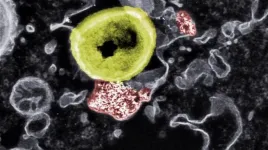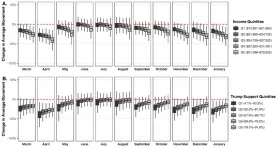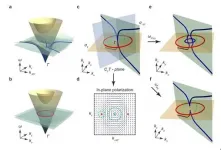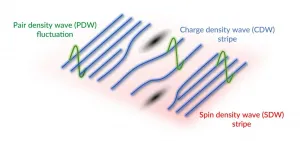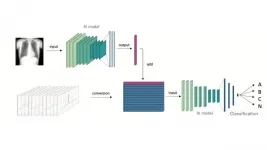(Press-News.org) COLUMBUS, Ohio - In the continuing search for dark matter in our universe, scientists believe they have found a unique and powerful detector: exoplanets.
In a new paper, two astrophysicists suggest dark matter could be detected by measuring the effect it has on the temperature of exoplanets, which are planets outside our solar system.
This could provide new insights into dark matter, the mysterious substance that can't be directly observed, but which makes up roughly 80% of the mass of the universe.
"We believe there should be about 300 billion exoplanets that are waiting to be discovered," said Juri Smirnov, a fellow at The Ohio State University's Center for Cosmology and Astroparticle Physics.
"Even finding and studying a small number of them could give us a great deal of information about dark matter that we don't know now."
Smirnov co-authored the paper with Rebecca Leane, a postdoctoral researcher at the SLAC National Accelerator Laboratory at Stanford University. It was published today (April 22, 2021) in the journal Physical Review Letters.
Smirnov said that when the gravity of exoplanets captures dark matter, the dark matter travels to the planetary core where it "annihilates" and releases its energy as heat. The more dark matter that is captured, the more it should heat up the exoplanet.
This heating could be measured by NASA's James Webb Space Telescope, an infrared telescope scheduled to launch in October that will be able to measure the temperature of distant exoplanets.
"If exoplanets have this anomalous heating associated with dark matter, we should be able to pick it up," Smirnov said.
Exoplanets may be particularly useful in detecting light dark matter, Smirnov said, which is dark matter with a lower mass. Researchers have not yet probed light dark matter by direct detection or other experiments.
Scientists believe that dark matter density increases toward the center of our Milky Way galaxy. If that is true, researchers should find that the closer planets are to the galactic center, the more their temperatures should rise.
"If we would find something like that, it would be amazing. Clearly, we would have found dark matter," Smirnov said.
Smirnov and Leane propose one type of search that would involve looking close to Earth at gas giants - so called "Super Jupiters" - and brown dwarfs for evidence of heating caused by dark matter. One advantage of using planets like this as dark matter detectors is that they don't have nuclear fusion, like stars do, so there is less "background heat" that would make it hard to find a dark matter signal.
In addition to this local search, the researchers suggest a search for distant rogue exoplanets that are no longer orbiting a star. The lack of radiation from a star would again cut down on interference that could obscure a signal from dark matter.
One of the best parts of using exoplanets as dark matter detectors is that it doesn't require any new types of instrumentation such as telescopes, or searches that aren't already being done, Smirnov said.
As of now, researchers have identified more than 4,300 confirmed exoplanets and an additional 5,695 candidates are currently under investigation. Gaia, a space observatory of the European Space Agency, is expected to identify tens of thousands more potential candidates in the next few years.
"With so many exoplanets being studied, we will have a tremendous opportunity to learn more than ever before about dark matter," Smirnov said.
INFORMATION:
Contact: Juri Smirnov, Smirnov.9@osu.edu
Written by Jeff Grabmeier, 614-292-8457; Grabmeier.1@osu.edu
In the arms race "mankind against bacteria", bacteria are currently ahead of us. Our former miracle weapons, antibiotics, are failing more and more frequently when germs use tricky maneuvers to protect themselves from the effects of these drugs. Some species even retreat into the inside of human cells, where they remain "invisible" to the immune system. These particularly dreaded pathogens include multi-resistant staphylococci (MRSA), which can cause life-threatening diseases such as sepsis or pneumonia.
In order to track down the germs in their hidouts and eliminate them, a team of researchers from Empa and ETH Zurich is now developing nanoparticles that use a completely different mode ...
BOSTON - For many patients with localized lung cancer (non-small-cell lung carcinoma and small cell lung carcinoma), high-dose radiation with concurrent chemotherapy is a potential cure. Yet this treatment can cause severe, acute inflammation of the esophagus (esophagitis) in about one in five patients, requiring hospitalization and placement of a feeding tube.
A team of radiation oncologists at Mass General Cancer Center demonstrate in an early clinical trial that the radiation beam can be carefully "sculpted" to deliver the majority of a radiation dose directly to the tumor while effectively sparing tissues in the side of the ...
Ann Arbor, April 22, 2021 - Using nearly a year of anonymous geolocation data from 15-17 million cell phone users in 3,037 United States counties, investigators have found that individuals with lower income per capita or greater Republican orientation were associated with significantly reduced social distancing throughout the study period from March 2020 through January 2021. Their findings are reported in the American Journal of Preventive Medicine, published by Elsevier.
The associations persisted after adjusting for a variety of county-level demographic and socioeconomic characteristics. Other county-level characteristics, such as the share of Black and Hispanic residents, were also associated ...
Topological photonics has attracted a lot of attention recently. The application of topological band theory to photonics not only opens the door to novel devices, but also stimulates the exploration of new topological phases. In the photonic regime, symmetries that are unique to electromagnetic (EM) waves can intrinsically protect the band degeneracies in the momentum space. Topological systems realized using such symmetries are uniquely "photonic", having no counterparts in electronic or phononic systems.
Among various topological features in momentum space, nodal chain is a special ...
Guilt and social pressure lead people to underreport COVID-19 protocol violations, according to study of experimental data across 12 countries.
Article Title: A guilt-free strategy increases self-reported non-compliance with COVID-19 preventive measures: Experimental evidence from 12 countries
Funding: J.-F. Daoust acknowledges the financial support from SSPS Open Access (University of Edinburgh). M. Foucault and S. Brouard acknowledge the financial support from ANR - REPEAT grant (Special COVID-19), CNRS, Fondation de l'innovation politique, as well as regions Nouvelle-Aquitaine and Occitanie. Richard Nadeau and Éric Bélanger acknowledge the financial support from the Social Sciences and Humanities Research Council (SSHRC/CRSH). M. Becher gratefully acknowledges ...
Unconventional superconductors contain a number of exotic phases of matter that are thought to play a role, for better or worse, in their ability to conduct electricity with 100% efficiency at much higher temperatures than scientists had thought possible - although still far short of the temperatures that would allow their wide deployment in perfectly efficient power lines, maglev trains and so on.
Now scientists at the Department of Energy's SLAC National Accelerator Laboratory have glimpsed the signature of one of those phases, known as pair-density waves or PDW, and confirmed that it's intertwined with another phase known as charge density wave (CDW) stripes - wavelike patterns of higher and lower ...
Substantial proportions of pregnant and postpartum women scored high for symptoms of anxiety, depression, loneliness and post-traumatic stress in relation to COVID-19 in a survey carried out in May and June 2020, according to a new study published this week in the open-access journal PLOS ONE by Karestan Koenen and Archana Basu of Harvard T.H. Chan School of Public Health, US, and colleagues.
Pregnant and postpartum women face unique challenges during the COVID-19 pandemic that may put them at elevated risk of mental health problems. These include concerns about ...
Time seems to pass more slowly in the UK COVID-19 lockdown - especially for people who are depressed, shielding or dissatisfied with social interactions
INFORMATION:
Article Title: Distortions to the passage of time during England's second national lockdown: A role for depression
Funding: The author received no specific funding for this work.
Competing Interests: The authors have declared that no competing interests exist.
Article URL: https://journals.plos.org/plosone/article?id=10.1371/journal.pone.0250412
...
Survey of 3,536 healthcare workers suggests 67 percent are suffering burnout, but people who receive frequent COVID-19 tests are less likely to be burned out.
INFORMATION:
Article Title: Determinants of burnout and other aspects of psychological well-being in healthcare workers during the Covid-19 pandemic: A multinational cross-sectional study
Funding: JK has received an educational grant from Johnson and Johnson.
Competing Interests: JK has received an educational grant from Johnson and Johnson. This does not alter our adherence to PLOS ONE ...
Kobe University Hospital's Dr. NISHIMORI Makoto and Project Assistant Professor KIUCHI Kunihiko et al. (of the Division of Cardiovascular Medicine, Department of Internal Medicine) have developed an AI that uses multiple kinds of test data to predict the location of surplus pathways in the heart called 'accessory pathways', which cause the heart to beat irregularly. In this study, the researchers were able to improve diagnosis accuracy by having the AI learn from two completely different types of test results- electrocardiography (ECG) data and X-ray images. It is hoped that this methodology can be applied to other disorders based upon the successful results of this research.
These ...
